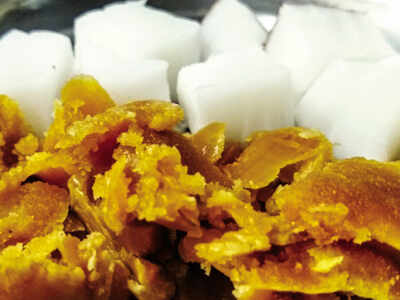
PANAJI: A social media message that smacked sentimentally of old traditions pleaded with members of a Whatsapp group “to eat coconut and jaggery first thing in the morning.”
“Hey fellow Goans (and even others). It’s the 1st of August today. In our home, it has been a tradition passed down to us from generations to eat jaggery and coconut…” the message read. The messenger cited heavy rains and change of weather during August, as a sound reason to beef up immunity. With the consciousness about healthy food heightened during Covid times, the viral post did trigger nostalgia among old timers. Younger members also evinced interest, and one of them even asked how palm jaggery is made.
Goa, though, a port of call for sea-going vessels from the world over in the bygone era was hardly importing nuts or they were beyond the common man’s palate. What grew locally and in abundance and was nutritionally loaded came handy for consumption. “Jaggery has lots of iron and other minerals. It is offered as prasad at gatherings and was served on auspicious occasions, like laying of a foundation stone,” Bernadette Pereira, a dietician and nutritionist said.
The coconut kernel with jaggery, either cane or palm jaggery, is considered a healthy food. Among Goan traditional foods, the same basic ingredients with rice can be used in diverse ways with different methods - steamed, deep fried, pounded or moulded. “This is an excellent source of nutrients such as calories, proteins, essential fatty acids and important minerals like iron and calcium. With no preservatives added, the nutritional value is enhanced significantly,” Pereira said. And it is considered a healthy snack for even patients with cardiac disabilities, pregnant mothers and growing children.
Catholics prepare pudde, patoyos and Hindus modak with these basic ingredients.
When food choices were limited some decades ago, people snacked delightfully on locally available, but wholesome items. “Nal’l and godd would make our mouths water. At other times, we had a choice of foods to make like patoyo, pinagre and other sweets and snacks,” Tereza Rodrigues, a senior citizen from Salcete said.
Many of these foods are made to suit the climate and availability of materials.
“Food is made according to the season and availability of ingredients. For instance, turmeric leaves which are used to make patoyo can be found aplenty during this season,” said Fatima da Silva Gracias, food historian.
With Goan food like khajem being granted geographical indication (GI), expectations have risen about tagging other produce. ”Rice, coconut and jaggery are important ingredients in Goan food or sweet dishes. Authorities should try to obtain GI tag to these unique and healthy foods,” said Mabel Menezes, chairperson of Chinchinim biodiversity management committee.
“Hey fellow Goans (and even others). It’s the 1st of August today. In our home, it has been a tradition passed down to us from generations to eat jaggery and coconut…” the message read. The messenger cited heavy rains and change of weather during August, as a sound reason to beef up immunity. With the consciousness about healthy food heightened during Covid times, the viral post did trigger nostalgia among old timers. Younger members also evinced interest, and one of them even asked how palm jaggery is made.
Goa, though, a port of call for sea-going vessels from the world over in the bygone era was hardly importing nuts or they were beyond the common man’s palate. What grew locally and in abundance and was nutritionally loaded came handy for consumption. “Jaggery has lots of iron and other minerals. It is offered as prasad at gatherings and was served on auspicious occasions, like laying of a foundation stone,” Bernadette Pereira, a dietician and nutritionist said.
The coconut kernel with jaggery, either cane or palm jaggery, is considered a healthy food. Among Goan traditional foods, the same basic ingredients with rice can be used in diverse ways with different methods - steamed, deep fried, pounded or moulded. “This is an excellent source of nutrients such as calories, proteins, essential fatty acids and important minerals like iron and calcium. With no preservatives added, the nutritional value is enhanced significantly,” Pereira said. And it is considered a healthy snack for even patients with cardiac disabilities, pregnant mothers and growing children.
Catholics prepare pudde, patoyos and Hindus modak with these basic ingredients.
When food choices were limited some decades ago, people snacked delightfully on locally available, but wholesome items. “Nal’l and godd would make our mouths water. At other times, we had a choice of foods to make like patoyo, pinagre and other sweets and snacks,” Tereza Rodrigues, a senior citizen from Salcete said.
Many of these foods are made to suit the climate and availability of materials.
“Food is made according to the season and availability of ingredients. For instance, turmeric leaves which are used to make patoyo can be found aplenty during this season,” said Fatima da Silva Gracias, food historian.
With Goan food like khajem being granted geographical indication (GI), expectations have risen about tagging other produce. ”Rice, coconut and jaggery are important ingredients in Goan food or sweet dishes. Authorities should try to obtain GI tag to these unique and healthy foods,” said Mabel Menezes, chairperson of Chinchinim biodiversity management committee.
Quick Links
Kerala Coronavirus Helpline NumberHaryana Coronavirus Helpline NumberUP Coronavirus Helpline NumberBareilly NewsBhopal NewsCoronavirus in DelhiCoronavirus in HyderabadCoronavirus in IndiaCoronavirus symptomsCoronavirusRajasthan Coronavirus Helpline NumberAditya ThackerayShiv SenaFire in MumbaiAP Coronavirus Helpline NumberArvind KejriwalJammu Kashmir Coronavirus Helpline NumberSrinagar encounter
Get the app








